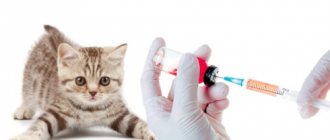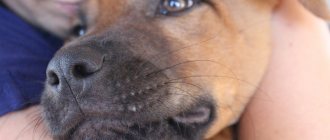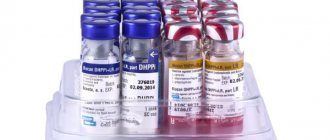What is canine distemper in dogs?
An infectious (viral) disease - canine distemper - can occur in three forms. The most dangerous is the hyperacute form; the disease is also divided into subacute and acute. In an animal, the infection causes disruption of the intestines, stomach and nervous system. Distemper can cause fever, conjunctivitis, diarrhea, inflammation of the mucous membranes and skin exanthema.
Individuals with weak immunity are susceptible to the disease, primarily puppies - their immunity has not yet been formed. The greatest risk of contracting distemper is in German shepherds, Chinese crested dogs, bull terriers, huskies, Pekingese, collies, pugs and lapdogs. Veterinarians have noticed that resistance to plague appears in terriers and mongrel dogs. The disease has no seasonality; it can appear at any time of the year.
Plague of carnivores has been known since the domestication of animals, and is widespread everywhere.
Symptoms and possible complications
For a positive prognosis, it is necessary to inject an antiviral drug as early as possible. The maximum effectiveness of the administered medication is achieved only in the first days after the onset of the disease. If you find at least one of the listed signs in your pet, contact a veterinary clinic immediately.
First signs
Drug therapy at the initial stage helps in 90% of cases. The first signs
of distemper in dogs include:
- disheveled wool;
- increased tearing of the eyes and the appearance of nasal discharge;
- swelling and redness of the eyes;
- fever and loss of appetite;
- apathy and depression;
- photophobia (the animal avoids sunlight and hides in dark places);
- cough;
- diarrhea with yellow excrement containing pieces of undigested food or blood clots.
The number and severity of symptoms varies individually. It depends on age, breed, immune status and many other factors. If signs of damage to the nervous system (convulsions, paralysis) are added to the listed symptoms, the chances of saving the pet are minimal, but it is still worth fighting for the dog’s life.
Which organs are most affected?
The greatest impact of distemper in dogs occurs on the respiratory tract, central nervous system and gastrointestinal tract. Negative consequences are possible even after recovery. Animals that have recovered from the disease may lose their vision and develop lameness along with epileptic seizures. Not all owners are ready to endure such consequences, therefore, when the spinal cord and brain are damaged, euthanasia is chosen.
Effectiveness of vaccination
Modern veterinary medicine does not guarantee complete protection against the disease, even if vaccinated. However, it reduces the risk. The canine distemper vaccine only “teaches” the body to resist the virus. Further fight against the disease depends on the animal’s immunity. Veterinarians can definitely say that a vaccinated animal tolerates distemper much easier and recovers faster.
Is distemper dangerous for humans and other domestic animals?
Paramyxovirus is not dangerous to humans, but is fatal to other domestic animals. For the entire period of illness and 1-3 months after recovery, the infected animal is isolated from healthy ones.
The only exception is cats. A completely different pathogen is responsible for the development of a similar disease in their body. A cat cannot get the disease, but it can become a carrier. In this case, mild cold symptoms may appear. They are not dangerous for your furry pet and disappear on their own.
Without treatment, the probability of death from paramyxovirus infection reaches 80%. The remaining 20% are due to complications such as blindness, lameness or epilepsy. The outcome is not the most pleasant, so veterinarians recommend not to neglect vaccination and seek help at the first warning signs.
The article is for informational purposes only. Contact your veterinarian!
How the plague vaccine works
After vaccination, dogs' bodies develop immunity. Vaccination provides increased protection against infection. In other words, after vaccination, the animal’s body independently searches for areas with weakened infectious agents and begins to secrete antibodies, which in turn subsequently neutralize the virus. When confronted with the causative agent of plague, the immune system will not allow the development of the disease.
Read Hookworm infection in dogs: the most effective treatment methods
There are several types of vaccines:
- monovalent - they contain antigens of one disease;
- polyvalent form immunity that resists several pathologies. Recommended for adult dogs.
Stages of the disease
Drug therapy based on the symptoms of distemper in dogs begins no earlier than the end of the incubation period. It lasts from 3 days to 3 weeks and depends on the state of the infected person’s immune system. It is only possible to detect symptoms and begin treatment for distemper in dogs on the first day only in cases of severe immunodeficiency.
After entering the body, the virus spreads through the bloodstream to all vital systems, causing serious disruptions in the functioning of internal organs. Its reproduction occurs in immune cells and lymph nodes. Because of this, the infected organism's defense against bacterial and fungal diseases is reduced. Infection of the nervous system occurs in the second week.
The first symptoms of canine distemper in dogs occur 3-90 days after infection. Such a long incubation period greatly interferes with diagnosis. Deviations can only be recognized by lethargy or low appetite. Veterinarians recommend being vigilant and paying attention to any changes in your pet’s usual behavior.
Vaccination schedule
According to the vaccination schedule, the first vaccination is given to the puppy one and a half to two months after birth. Immediately after birth, the puppy’s blood contains antibodies that enter the blood through the placenta or through the mother’s milk. They are enough to protect a newly born dog from infections and diseases, but after a month and a half their effect ends, which means the mother’s protection weakens.
You should not get vaccinated before 1.5-2 months, as the immune response may not form. Puppies receive their first vaccination at six to ten weeks of age.
Approximate disease prevention scheme:
- The first vaccination against distemper, enteritis, parainfluenza, infectious hepatitis, leptospirosis is given at 8-10 weeks of the dog’s life, the second after 21-28 days, revaccinated at 1 year
- Rabies is first vaccinated at 12-13 weeks of life, a second vaccination is not given, revaccination is carried out annually.
- Against diseases such as trichophytosis and microsporia, the dog is initially vaccinated at 1-6 months, the second vaccination is given after 10-14 days, and revaccination is given annually.
- Revaccination is recommended to be done after the dog’s baby teeth have been replaced.
Veterinarians suggest vaccinating puppies of different breeds at the following ages:
- alabai – age 2.4 months, then a year;
- Shepherd, Yorkie – 3.4 months, one year;
- toy terrier, sharpei – 2, 6 months, year;
- Spitz, dachshund, spaniel - at 6, 10 and 12 weeks, a year;
- Labrador, husky, chihuahua – 8, 12 weeks, one year;
- French bulldog – 10 weeks, 7 months, the third vaccination is given per year.
Caring for the animal after vaccination
To form stable immunity in a pet, it should be created certain conditions for two weeks, excluding:
- water procedures;
- communication with other animals;
- change of food;
- active physical activity;
- stress;
- exposure to thermal factors;
- the use of anthelmintic and hormonal drugs, as well as antibiotics.
During this period, it is strictly prohibited to participate in exhibitions and other public events.
Owners should be aware that stress factors that have a negative impact on the health of a pet include loud screams, quarrels, the appearance of strangers and new pets in the house.
Types of drugs for vaccinations
The vaccine is often administered intramuscularly and subcutaneously. After the vaccine is administered, immunity will develop within 3-4 weeks. There are many drugs for vaccination, both domestic and foreign:
- Nubivak DHP – forms protection against plague, viral hepatitis and parvovirus enteritis.
- Nubivak DHPPi is a “live” polyvaccine.
- Nubivak PuppyDP is also a dry “live” vaccine. Suitable for vaccination of puppies from one month of age.
- Biovac - 1000 rubles and more, domestic vaccine (can be given at home).
- Hexadog – protects the pet from damage by parvovirus and adenovirus.
- Eurican.
- Multikan - 1000 rubles and above, domestic vaccine (can be administered at home).
- Duramun Max 5/4L – forms immunity against parainfluenza, hepatitis, enteritis and plague.
Read Dog poisoning: symptoms, treatment, first aid
The cost of the drug Nubivak can reach up to 1,500 rubles. All prices are approximate and will vary depending on the region of residence and whether the vaccination is given at home or at a veterinarian.
Sometimes owners do not have the funds to purchase expensive vaccines for their pet. You can save money and purchase a domestic complex vaccine or drugs intended to prevent only certain diseases, but this will not reduce the cost much.
Administering a vaccine dose is a simple process, but requires certain skills. Vaccinations can be administered free of charge at state veterinary clinics. In this case, you need to be prepared to stand in a decent line or wait until the veterinarian is “at lunch.”
Free vaccination of dogs is carried out exclusively against rabies. This is done because the disease is transmitted to humans. Secondly, most often this service is provided free of charge only in those areas that are considered distressed in terms of the spread of a particular disease. It is unlikely that it will be possible to obtain a full range of vaccinations, which will include a vaccine against canine distemper.
But we still shouldn’t forget about such public clinics. They often do not have high service level, but there are also no markups “for consultation”, “for service”, etc. Payment is made exclusively for vaccination, and in most cases you will be offered the most effective and affordable drug. Thus, even if you do not get completely free vaccinations for your dog, you will save a lot of money.
Vaccinating a dog against distemper
The most terrible diseases of dogs are enteritis, hepatitis, plague and rabies. In our country, as well as abroad, there are monovalent and multivalent vaccines.
Single-component vaccines
Single-component drugs provide immunity to only one pathogen, while multicomponent drugs provide immunity to several. The advantages of single-component vaccines are that the pet tolerates the vaccine much easier, and the load on the immune system in this case is less. That is, it is easier for the immune system to fight one disease than several at the same time.
Before vaccination, the veterinarian must check the expiration date indicated on the bottle. If the vaccine is expired, the vaccination will have no effect. Vaccination should be carried out in specialized clinics - come to our veterinary clinic.
Pets should be vaccinated against plague at an early age, preferably with a vaccine from a domestic manufacturer, since after using an imported vaccine there have been cases of plague.
Vaccines against plague
Veterinary clinics have three vaccines against plague in their arsenal: EPM, 668-KF and Vakchum. The EPM vaccine has an age limit - it cannot be given to puppies under three months of age. That's all for monovalent vaccines.
Multicomponent vaccines
If we talk about multicomponent vaccines, they are usually given to adult pets. One vaccination contains two or more viruses at once, which significantly saves your money and time, and you save your pet from unpleasant procedures.
Preparing for vaccination
Only healthy animals are allowed to be vaccinated. Before vaccination, a specialist conducts a comprehensive examination of the dog’s condition. The examination includes measuring body temperature and drawing blood for analysis. And only after the veterinarian is convinced that there are no contraindications, immunization is performed.
Vaccination is not carried out during the change of teeth. The vaccination is given either before or after the complete replacement of baby teeth.
A recent infection is also a contraindication. In this case, immunization is postponed to another time, when the four-legged friend is completely healthy.
Read Causes of alopecia in Spitz: effective ways to eliminate the problem
Two weeks before vaccination, the animal must be dewormed. For this purpose, special anthelmintics are used in tablets; there are also emulsions for puppies and adults, which can be purchased at a veterinary pharmacy, clinic, or pet store in any city. At the same time, dogs are treated against ectoparasites with insecticidal and acaricidal agents (for example, Bars Forte, Dana, Advocate).
How to store the vaccine
When purchasing a drug, you must ask the pharmacy seller to provide instructions for it. Optimal storage conditions are indicated there.
Most of these products are stored at a temperature of 2...8 °C. Freezing ampoules is prohibited, since the properties are lost in the same way as when heated. To deliver the drug from the veterinary pharmacy to your home, special thermal container bags are used. Such products are on sale. Some pharmacies rent bags with a deposit. To ensure the safety of the drug, some kind of refrigerant is placed inside - “dry ice”, ice cream, a bottle of frozen water.
Special container bags are used for delivery.
A low-quality vaccine is always dangerous. In the “best” case, it will turn out to be plain water without a therapeutic effect. This will not harm the animal, but the body will not receive immunity to the infection. In the worst case, it will cause an allergic reaction and lead to death.
Condition after the vaccine
After vaccination is carried out, the owner needs to monitor the condition of the pet. We need to pay more attention to his habits and well-being. In most cases, vaccinations against plague and other infectious diseases are safe, but there are deviations.
After vaccination against canine distemper, it is very important to keep your pet in quarantine for 10-15 days - during this time immunity is developed. You cannot walk with the puppy at this time; you should also limit contact with relatives, especially with stray dogs, birds and rodents.
Adverse reactions to the vaccine may include:
- loss of interest in the surrounding life, loss of strength and grumpiness;
- lack of physical activity;
- allergic rash;
- blue discoloration of the skin and mucous membranes;
- elevated temperature;
- upset stomach, nausea, vomiting.
In the days after vaccination, the pet will be very susceptible, so it is worth protecting it from stress, avoiding hypothermia and intense physical activity. If you have any alarming symptoms, you should immediately take your dog to the veterinary clinic for an appointment with a veterinarian.
What should you pay attention to after vaccinations for your puppy?
In 5% of dogs, a slight swelling forms at the injection site, which does not require treatment. After 1-3 weeks, the lump will resolve on its own. If the swelling area has increased or the swelling has not gone down after 3 weeks, you should see a veterinarian.
Allergies to the vaccine are also rare. The development of anaphylactic shock, which develops 5-15 minutes after the injection, cannot be ruled out, but this possibility is extremely rare.
On the day of vaccination and the next day, such reactions may develop. Which are considered normal:
- Increase in body temperature to 39 degrees.
- One-time refusal of food.
- Diarrhea or vomiting that occurs once.
- The first time after vaccination the puppy becomes lethargic.
At this time, it is better not to disturb the dog again, not to take it for a walk, not to bathe it.
It is not recommended to vaccinate a purchased puppy immediately after purchase. He requires quarantine for 2-3 weeks for health monitoring and a veterinary examination. If this is not done, there is a possibility of infection. Vaccination of an already infected animal can result in the death of the latter.
After receiving the vaccine, the dog is kept in quarantine for 10–14 days to develop lasting immunity. They don’t refuse walks. But their duration is reduced to the minimum necessary, especially in unfavorable weather conditions, in order to prevent hypothermia. They try to exclude contacts with other animals, in particular stray ones. Physical activity is also limited.
Don't miss a walk during quarantine
After vaccination, it is recommended to organize a quarantine for the puppy:
- isolate the puppy from other animals for 10-14 days;
- ensure normal sleep;
- provide adequate nutrition;
- give enough water;
- the puppy should be protected from drafts;
- Do not wash or bathe the puppy. The injection site should not be wetted for 3 days;
- do not overwork the puppy or subject it to increased physical stress;
We invite you to read: How and what to feed a Russian Spaniel puppy, menu by age
It should be noted that any vaccination is an intervention in the puppy’s immune system, therefore, immediately after vaccination, the resistance of his body is greatly weakened. On the first day after vaccination, you may notice excessive drowsiness, lethargy, a slight increase in the puppy’s body temperature (up to 39 °C), and sometimes vomiting is possible.
But don’t be too scared, as this is an absolutely normal reaction of the immune system to the entry of a foreign substance into the body. You should be wary only if the above symptoms do not stop and even intensify in the following days. In such a situation, you need to contact a veterinarian and consult about any abnormalities in the puppy’s condition.
In rare cases, puppy vaccinations can cause an allergic reaction to the vaccine. Allergy symptoms in this case may include:
- increased body temperature more than 39 °C;
- repeated vomiting and diarrhea;
- shortness of breath;
- excessive salivation;
- change in skin color;
- pallor of the mucous membranes;
It is not uncommon for puppies to develop lumps in the injection area after vaccination. This unpleasant phenomenon can occur if the injection site was chosen incorrectly, or the drug was administered too quickly. There is no need to be afraid of this, since usually such a lump resolves on its own within a week or a month. To speed up healing, it is recommended to use anticoagulant ointments that improve blood flow in the injection area.
Puppy vaccination measures impose certain restrictions on walks. Today we will look at when and after what vaccination you can walk your puppy, as well as what rules you need to take into account.
No vaccinations
Is it possible to walk with a puppy without vaccinations? Before the first vaccination, it is generally not recommended to walk with the puppy, since until 6 weeks of age the puppy’s immune system is not yet fully formed; maternal antibodies in its body provide only passive immunity, which will not be able to provide adequate protection against dangerous and aggressive potential diseases.
Dogs are very curious animals, and this circumstance can lead to accidental infection of the puppy during a walk. Since most diseases in dogs are transmitted through secretions, saliva or urine from a sick animal can get on your puppy’s paws or nose during a walk, which is almost 100% likely to lead to infection.
Things are a little different with walks after the first vaccination. As mentioned above, long-term active immunity in a puppy is not formed immediately, but after some time. Therefore, it is customary to vaccinate puppies in two stages, since the first vaccination creates the body’s primary immune response, and the second strengthens and stabilizes it. So is it possible for a puppy to go for walks after the first vaccination?
At the first stage of vaccination, a certain amount of weakened pathogens of the disease is introduced into the puppy’s body, forcing its immunity to independently fight the dangerous virus and produce antibodies to this disease. Depending on the age of the dog and the type of vaccine, the process of developing immunity can take 2-3 days or 2-3 weeks.
How long after the second vaccination can a puppy go for walks? After the second (fixing) vaccination of the puppy occurs in 12-14 days, full walks can begin within 10 days. During this time, the puppy’s immune system will fully adapt to protect against a specific disease.
Regarding adult dogs, the recommendations are rather conditional. During the week after vaccination, you can easily walk your pet on a leash without overcooling or giving him increased physical activity. But even an adult dog should not be allowed to interact with other animals for a week after vaccination.
In this regard, quarantine must be observed for 12-14 days after the first stage of puppy vaccination. Walking is not completely prohibited, but a number of rules must be followed:
- Find a quiet and safe place to walk your puppy.
- Under no circumstances should you allow your puppy to come into contact with other animals while walking.
- It is advisable to hold the puppy in your arms at all times and not let him run on the ground.
- You shouldn't stay outside for a long time; 20-minute walks in the fresh air are enough.
Walking dogs is a source of endless pleasure. Dogs, by their nature, are explorers; you should not deprive them of such simple joys of life as walks; you only need to limit walking for a short time before and after vaccinations. And when your pet’s immunity is fully strengthened, you can walk and play in the fresh air with him as long as possible; your puppy will definitely appreciate it.
To summarize, it should be noted that before any vaccination you should make sure that your pet is in complete health and well-being. Be sure to monitor the animal's appetite and behavior. Don’t neglect the little things, because it could cost your puppy’s life. And remember that no vaccine by itself provides one hundred percent protection against disease.
Still have questions? You can ask them to our site's in-house veterinarian in the comment box below, who will respond to them as soon as possible.











